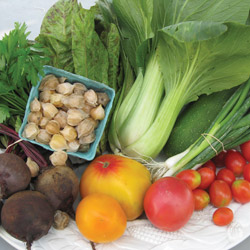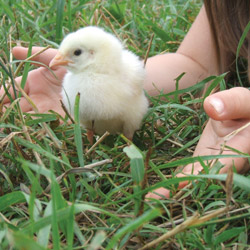
Navigating the vast network of food aisles of a Wal-Mart Superstore, bathed in the sterile glow of fluorescent lights, it’s easy to feel a bit distanced from one’s community. The familiar layouts of large grocery chains remind us that the stores themselves are not unique to our city; yet, we are often willing to accept the impersonal in order to save a few bucks. But this sense of disconnect that pervades the produce section at local chain stores isn’t mere abstraction or aesthetic quibbling.
Pick up any random fruit or vegetable and try to guess its origin. Think it was locally grown? That apple in your hand is just as likely to have come from another continent.
Remember the spare change you saved shopping at Wal-Mart? It is a pittance when measured against the State of Illinois’ annual food expenditures—$48 billion, nearly all of which goes out of state. To put that $48 billion in perspective, the sum nearly equals our state government’s annual budget. Yet we continue to export billions of local dollars to California, Mexico, China and elsewhere each year. So what would it mean to keep more of this money in Illinois by buying from local farms?
Benefits of Buying Local
The Illinois Local and Organic Food Task Force was founded in 2007 to address this problem and find ways to keep that money in the state. The task force believes that growing most of our food within the area by expanding local farm and food networks could help Illinois retain $20 to 30 billion of the money that flows out of the state each year. That would mean new agricultural and economic opportunities.
In 2009, the task force released a report to explain what this money could mean for Illinois residents. New markets would open for area farmers, and the extra money could go toward providing affordable financing and insurance for new and transitioning farmers and ensuring jobs and incentives for farm labor.
The report also noted that economic developers and workforce officials see that money as a means to reinvigorate commerce and industry. The emergence of locally grown food would necessitate a supply chain that includes aggregating, processing, packaging, transporting and storing—a process that, in turn, engenders jobs that cannot be outsourced.

However, cooperation between farmers and the state means little if the public does not support small farmers. The transition toward a functional, locally grown food market will require collective community involvement, making it a grassroots movement of sorts. The Local and Organic Task Force reported that the public has become increasingly interested in the fresh taste of produce grown close to home.
Many grocery shoppers may be a bit perplexed about just how to buy their groceries from small area farms; however, a subscription goods service, known as Community Supported Agriculture—or, alternately Consumer Supported Agriculture (CSA), has developed.
Consumer Convenience, Community Cooperation
Over the last 20 years, CSA farms have become essential parts of the locally grown food movement. CSA farmers offer shares of produce and other farm products at a fixed subscription price. Consumers may buy a membership to a nearby CSA to receive weekly shares of boxes or baskets of seasonal food.
Finding the nearest local CSA is as simple as logging onto websites such as localharvest.org and illinoisfarmdirect.org, which offer consumer directories that are searchable by location. These sites, which provide context and some of the questions you may want to ask before purchasing a CSA subscription, are also excellent primers for uninitiated buyers.
So what is Community Supported Agriculture, other than a name? The process was founded on the principle of shared risks for small farmers who would otherwise have to shoulder the burden of uncertainty—an unavoidable part of the growing process—alone. As such, if bad weather hampers seasonal crops, subscribers will probably receive smaller shares; if there is a surplus, consumers share in the excess.
Consumers, through the purchase of a subscription, have easy access to the freshest farm products available. They also have the opportunity to develop a beneficial relationship with the growers—something that just isn’t possible when shopping at a Wal-Mart Superstore.
Josh Adams, chef and owner of June restaurant in Peoria Heights, is, notably, a local foods enthusiast. Explaining his relationship with local farmers, he remarks that his constant contact with area CSAs such as Henry’s Farm “inspires and sets our menu. We’re an extension of the farm. What they grow is what we serve.”
Illinois Farm Direct emphasizes the positive relationships that grassroots involvement can cultivate. Their website suggests that consumers, in developing friendships with local farmers, can encourage them to grow “favorite foods” and do so in an “environmentally and socially sound manner.”
Adams’ personal experience with buying locally reflects this sentiment. “You get peace of mind from seeing the conditions meat and vegetables come from,” he says.
CSA subscriptions don’t just provide consumers with the possibility of ecologically responsible food purchases. Customers are typically guaranteed to receive the freshest—and generally the tastiest—groceries available.
Passion Fruit (And Vegetables)
Forget, for a second, the economic and environmental benefits of shopping with CSA farms. For some, the most important factor when choosing a grocery supplier is simple: taste. Major grocery retailers who import their goods from across state lines have difficulty competing with local farmers in terms of freshness.
“A very small percentage of what’s sold in our grocery stores comes from the Midwest,” says Adams. “By the time you actually eat one of their vegetables, it’s probably been out of the ground ten days.” He compares this estimate to the freshness of produce from CSAs. “When we eat local, the same vegetable has been out of the ground for 24 hours or less.”
He attributes much of his success to his belief in locally grown products. “I don’t think our food would taste the way it tastes without the work they do,” says Adams of CSA farms.
“Big industrial farms mistreat their animals,” Adams believes. “They don’t put any care or love into their vegetables at all.” This contrasts sharply with CSA farms. “Any of the farmers I know would be more than happy to show someone the conditions their animals are raised in,” he adds.
This “care and love,” often absent from large industrial farms, seems to be the founding principle of the Wyoming, Illinois-based CSA Broad Branch Farm. Anita Poeppel of Broad Branch speaks passionately of produce and livestock. “We’re very particular about handling—making sure everything is handled gently and appropriately.”
“We are about as picky—as far as the cleanliness of the food—as anybody,” she explains. Poeppel’s ardor is not reserved for livestock and produce, though. Farming, for her, is a process that strengthens family and community bonds.
“What’s important is that our children love this farm,” she stresses. It’s difficult to doubt her earnestness regarding locally grown foods from small farms. “We’re so excited about what we’re doing, customers get excited. If they’re leaving our CSA to start their own garden, then we’ve done a good job.” iBi

